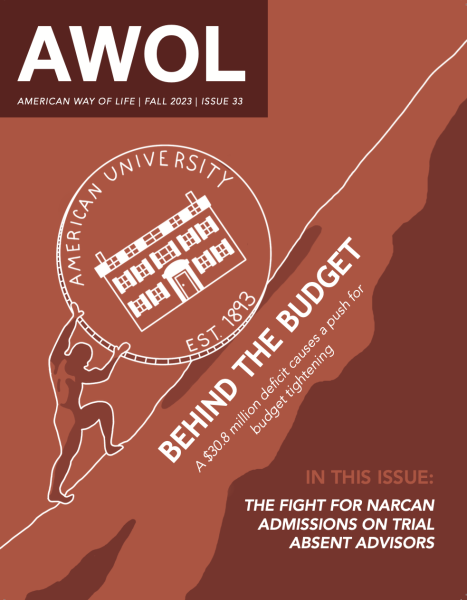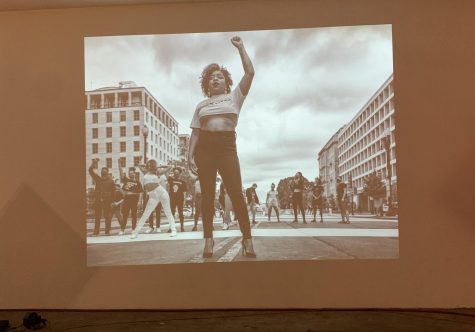Seoul Searching: K-Pop’s Cultural Divide
K-pop, the Korean popular music genre stereotyped as nothing more than makeup-clad boys, crazy music videos and the “Gangnam Style” dance, has become a sensation around the globe. K-pop, though, is a whole lot more than its stereotypes — it is an entire music industry, with all of its own inner complexities and issues.
The Gangnam Style fad has died, but this genre’s international popularity has risen astronomically in recent years. According to Entertainment Tonight, the megastar K-pop boy band BTS just broke Taylor Swift’s record for the most viewed music video within 24 hours. The attendance this year at Korea Convention (KCON) in Los Angeles alone was a record breaking 94,000 people, as reported by Broadway World.
While K-pop refers to Korean popular culture in general, the music itself can have different definitions depending on each person’s perspective.
Jisung Kim, a first-year student at American University, called it “an approach to American music with a Korean twist.”
Lauren Seals, a senior at AU and president of the AU K-District Dance Team, added “[K-pop has] a Motown perspective brought into it, because if you look back into the history of Motown, it was very curated. So I think K-pop takes that same popular method and really makes it work.”
The true beginning of K-pop actually lies in the 1987 South Korean presidential elections.
Prior to the 1987 elections, South Korean media was heavily controlled by the state. Most music people listened to was determined by winners of weekly musical talent shows on one of the two broadcasting networks: Korean Broadcasting Systems (KBS) and Munhwa Broadcasting Corporation (MBC).
The music was also tightly controlled and often banned for any content that was deemed inappropriate. Independent music-making was practically unheard of. However, the 1987 election changed all that because it became the election that truly democratized South Korea.
Entertainment content, like music, was no longer so restrained, and South Koreans had the opportunity to listen to American music for the first time. This led to what many credit as the first K-pop song: “Nan Arayo (I Know).”
The hip hop-inspired single was performed for the first time on April 11, 1992 at a talent show by Seo Taji and the Boys, the first group of its kind in South Korea. Their performance that day gained them the lowest score of the evening, but 17 weeks at the top of the charts and a record that lasted for fifteen years.
Many other artists followed quickly in their footsteps, chasing the success the group had acquired with their Western, hip-hop style music that was sung in Korean and performed with highly choreographed dances.
K-pop companies then started stepping onto the scene for the first time, with the development of the “the big three”– the three largest and most successful K-pop companies that still dominate much of the market today.
One of the big three, SM Entertainment, brought South Korea H.O.T., or High five Of Teenagers — the first exemplification of an idol group. The five-member boy group had all the major characteristics of today’s idol groups: a combination of singing, dancing and rapping with an emphasis on style, looks, and personality.
That first idol group also set the standard for the genre’s emphasis on machine-like perfection, a characteristic that attracted many fans but also led to a harmful culture of placing the idols’ wellbeing at a lower priority. As a result, many K-pop fans are the first to point out problems with the industry, since those issues center around how idols are affected.
Seals went in more depth when asked specifically about problems in the industry: “Notice how people say the K-pop industry, because it’s very factory-run. There’s no real care for the well-being of the idol, and the fact that they just want them to churn out music and produce and release and promote—that’s not sustainable.”
Even though K-pop fans are often the ones to call for better treatment of the idols, the fans’ own mindsets often become part of the problem. Much of this is due to the capitalist nature of the industry and how it runs on those problematic mindsets, Seals said.
“The expectations that idols are your property is one of the biggest issues that I still struggle with,” Seals said. “Because if the fans put in money, they think ‘I own you.’ So I think one of the biggest issues I have with the industry is the entitlement fans feel with the idols.”
International discussions on K-pop often deal with cultural appropriation. K-pop began from a hip-hop inspired song and most songs feature rap, even if they’re not considered “hip-hop music.”
Because black hip-hop artists created rapping, some consider this to be appropriation.
Many K-pop artists will also wear stereotypically hip hop clothing or act in a certain fashion because of how they perceive hip hop culture. G-Dragon, a prominent member of the very popular boy group Big Bang, wore dreads in his solo music video “One of A Kind,” and there have been some cases of other idols donning blackface, such as when the girl group Mamamoo painted their faces with brown paint in an on-stage parody of Bruno Mars’s “Uptown Funk” song.
“It’s a problem within Korea that they’re taking [rap] and turning it into bite-sized little soundbites,” Maria Freedman, a first-year student at AU, said. “It’s like a costume. They’re putting on this persona, and a lot of them don’t get what that means, like why that persona was the culture around rap music.”
“That was one of the reasons I took a break from K-pop for a little bit,” Seals said “There have been cases where I just don’t listen to groups anymore because the scandal was so bad that it hurt me on a personal level, being a black person, where I was like—you know what, I can deal without their music. Overall, it’s just….something that can’t be avoided.”.
The American perspective makes appropriation in Korea difficult to look at, according to Elizabeth Anderson, a sophomore at AU and part of the K-District Dance Team.
“As far as the dreads and the grills go, there seems to be a different perception of racism in Korean culture,” Anderson said. “And I don’t want to speak for it, because I’m not Korean and I’m a white American, so I see it through a lens. From what I’ve seen, it’s not really seen as appropriation in Korea. It’s just seen as a style or trend.”
Jisung, who is Korean American and who grew up in America, but lived in Korea from 2013 to 2015, has been able to see the perspectives of both cultures.
“In the industry, they’ve really been trying to appropriate black music and rap music and things like that. And I think they don’t know that they are…but without knowing, they’re just doing it,” Kim said.
A lot of fans say the same; many South Koreans don’t know the implications behind these kinds of actions.
“My opinion on appropriation and K-pop at first was that they don’t really know better because there aren’t a lot of Americans there, but that’s not true,” Seals said. “Especially with globalization of social media, there’s no excuse at this point.”
There is also the issue of international fans appropriating Korean culture. This raises questions around where to draw the line when it comes to appreciating versus appropriating Korean culture.
One example of this is the K-pop group “EXP Edition.” This is the first K-pop group that has white members—in fact, three of the four members are white (one is half Japanese and half German). They sing in Korean, live in Korea and market themselves as K-pop idols.
When asked about EXP Edition, Minkyu Sung, a first-year at American who was born and raised in South Korea, said K-pop is getting more diverse.
It’s true that more and more K-pop idols are coming from countries other than South Korea, with one example being the popular boy group GOT7, who include Chinese-American, Chinese, and Thai members. Traditionally, idols have been either been from an Asian country or had Asian ancestry.
“There are members of groups from like Taiwan and Thailand, but they’re still Asian so it’s more normal. Still, as a listener of K-pop it can be weird to listen to a white K-pop group, ” Sung continued.
“America has a legacy of orientalism and fetishizing East Asian women and dehumanizing Asian men, and I think that’s where the sour taste in everyone’s mouth comes from,” Seals said “I think that’s where the fury of the fandoms comes from, where it’s like, America has done this, so why do you need to have your white hands on something that is produced from South Korea?”
Freedman said the members of EXP Edition are “Koreaboos,” which is a familiar term to many in the international K-pop fandom.
“Koreaboos only take the K-pop and K-drama parts, the parts they like about K-pop culture and claim it as their own…but the parts they take are only the parts that are prepackaged to be acceptable,” Freedman said “There’s so much more to Korean culture and Korea itself that they are just so ignorant of and don’t even consider.”
Since the rise of K-pop internationally, the term “Koreaboo” has become popularized as some fans have been accused of fetishizing Korean culture, such as on the Tumblr page “Koreaboo Stories,” where anonymous users post stories about people they deem to be koreaboos. This is exemplified in one anonymous user’s post, where they stated, “A lot of my school mates are getting into Kpop/Kdrama and even into Korean Culture just because it’s a fad and it pisses me off because they’re cringy koreaboos.” The consequence of this has been a general perception that all K-pop fans are like that, which is now a common stereotype.
The term “Koreaboo” is only really used by international people to point fingers at other international fans, which begs the question of whether Koreaboos are seen as a real problem by native Koreans.
“I like to share the culture of Korea, but…Korean culture is very broad, and K-pop is just a tiny part. So when people like K-pop but aren’t understanding of the whole Korean culture, that’s when it’s not as good,” Sung said.
Kim was more concise in his opinion of Western fans in general: “I don’t really think it’s cultural appropriation, I think it’s just more of like an appreciation rather than appropriation.”
Beyond individual joy, some are still hopeful for larger positive consequences of the spread of K-pop, beginning with the possibility of changing how East Asians are represented in Western media.
“I’ve definitely noticed a stereotype with Asian men being small and just there for comedic purposes, as well as seeing Asian women as submissive or sexually fluid. Also, I would like to see a lot more Asian American acceptance in the music industry,” Seals said.
Some argue that K-pop could have a large role in changing these stereotypes, especially because of the genre’s emphasis on modernization and breaking old traditions.
“People around the world think that East Asians are really quiet and respectful of their elders, but we’re not all like that. And K-pop is definitely changing perceptions, because…they are showing that they are not the typical Asians people think of,” Sung said.
Seals, while less sure about the role of K-pop, still could see the possibility of change when asked if K-pop could change those perceptions.
“In a very small way, K-pop is a slice of a lot of different Western and Eastern influences, and it definitely doesn’t represent Eastern Asia at all. I think it just helps with the ideas. With K-pop one of the selling points is its sexy concepts, which has helped out in that it shows that Asian men can be sexy,” she said.
The K-pop industry is certainly more complex than many may think, with appropriation, globalization, and modernization all rolled into one booming music genre. For many people looking at this industry from the outside, this can all seem pretty overwhelming.
To new fans, Freedman advised, “I feel like there’s no right or wrong way to get into K-pop. You might cry about not being able to go to those concerts, but I feel like K-pop kind of speaks for itself.”

Grace Vitaglione (she/her/hers) is a junior from West Virginia studying journalism at American University, with minors in Creative Writing and Spanish....












